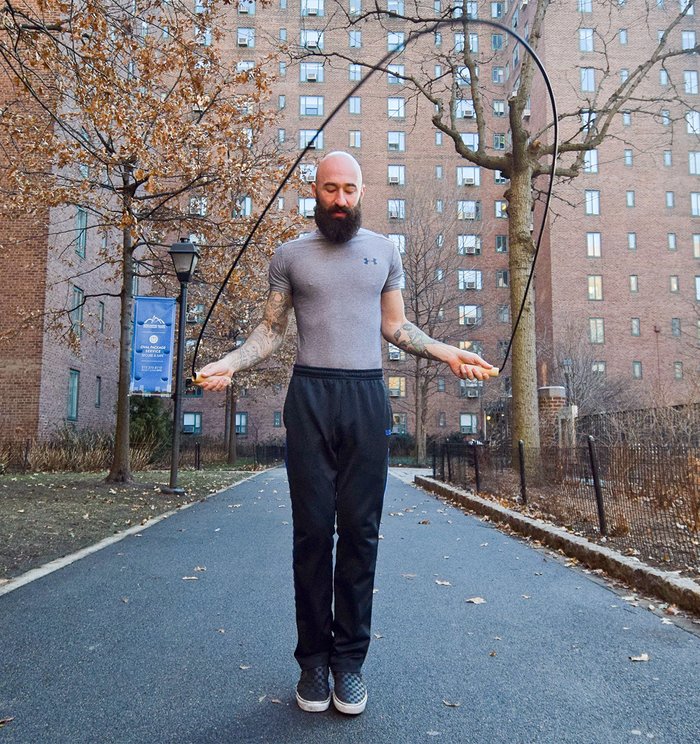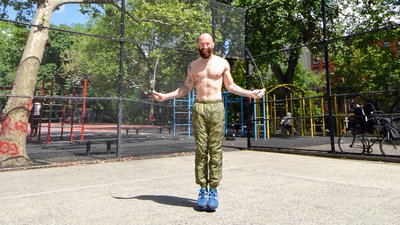When it comes to cardio, many people assume their options are limited to slugging it out on a machine of some type. But what if you don't have access to a machine, or simply don't want to bother with one? That's when it's time to pull out the jump rope.
That's right: When it comes to burning fat and working your cardiovascular system, a jump rope is the only piece of equipment you need. Besides requiring a much smaller financial investment than a gym membership or home cardio machine, you can do it just about anywhere.
But aside from what it can do for your heart and your waistline, jumping rope can also have a huge impact on improving your coordination and agility. In fact, those aspects of jumping rope can often be the most limiting factors at first. There is a bit more skill involved than there is with most other forms of exercise. As such, many people will need to practice their technique a bit before they are able to use the rope to its full potential.

Here's where to start, and what to practice to take it to the next level.
Single-Rep Two-Foot Jumps, Then Multi-Rep Jumps
The first technique you need to learn is the standard two-foot jump. Think that's too basic? Believe me, it's not.
Start with the rope behind your heels, then whip it over your head and jump over it with both feet at the same time—just once. That's right, I actually recommend simply practicing single jumps, resetting your rope after each rep, particularly if jumping rope is relatively new to you. This may feel a bit strange at first, but if you stick with it for a bit, you'll find it carries over into helping you transition between jumps as smoothly as possible.
It's common for people to work harder than necessary when first learning, so it might be very tiring at first. Beginners tend to jump higher than needed, which makes for considerably more work. The good thing about this, of course, is that you will expend a lot of energy and therefore burn up a lot of calories. The bad thing is that you will need to take a lot of breaks in order to recover.
What's the fix? Aim to keep your jumps relatively low to the ground in order to be as efficient as possible with your energy. This will allow you to eventually jump for longer periods of time without needing to stop and rest. Stay light on your feet, keep your weight toward your toes, and engage your abs. As your coordination improves, you'll be able to make your jumps only as high as they need to be in order to clear the rope.
Alternating Single-Foot Jumps
Once you've gotten comfortable jumping with both feet at the same time, try alternating feet, like you are jogging in place while the rope passes beneath you on each step. It will take some practice to get the hang of this, and it may feel awkward at first, but in time you should feel just as natural jumping in this fashion as with both feet together.
In addition to alternating feet on every jump, I recommend practicing repeated single-foot jumps. For example, perform two left-foot jumps followed by two right-foot jumps. Again, stay light on your feet and keep your weight toward your toes.
It's also helpful to practice transitioning between standard two-foot jumps and alternating single-foot jumps. One of my favorite sequences is four standard two-foot jumps immediately followed by four alternating single-foot jumps. I like to repeat this sequence, gradually picking up the pace as I get into the rhythm.
Cross-Over Jumps
After you're comfortable with the basics, start to play around with cross-over jumps. This means you switch the position of both hands to the opposite sides, so your left hand winds up outside your right hip and your right hand is outside your left hip.
It takes focus and coordination to get the timing right for this one, so be prepared to put in some practice before you can perform it consistently. You may need to jump a bit higher in order to stay in the air long enough to cross your hands back and forth between jumps.
Double-Unders
A double-under refers to a jump in which the rope goes underneath the feet twice during a single jump. In order to perform a successful double-under, you'll need to whip the rope extremely quickly and jump higher than normal to make room for the rope to pass beneath you twice before you land.
Additionally, I recommend reaching your legs slightly forward at the top of your jump in order to create more space between the ground and your feet. This is a skill that takes time to master, so don't rush it.
Programming Your Jump-Rope Workout
In the beginning, I suggest simply practicing the basic techniques before you worry about any specific programming. You can practice for a few minutes at the start of your workout as a warm-up, or do it at the end. You can also do it on a separate day entirely. As long as you get it in, when you do it is up to you.
Once you can comfortably jump continuously for at least a minute, you're ready to stretch it out into a full-fledged workout. A great place to start is with intervals where you alternate between a minute of jumping and a minute of rest. Keeping that pace up for 20 minutes can be surprisingly tough at first, so don't feel like you have to chase maximum intensity every minute! As your technique and conditioning improve, you can aim to make your jumping intervals longer and your breaks shorter. You can also increase the length of your sessions.
For variety's sake, I recommend practicing some cross-overs and double-unders, particularly during longer sessions. Be aware that these moves will be more tiring, however, so you may need to adjust your work-to-rest ratio to account for this.
One of my favorite ways to practice cross-overs and double-unders is simply to pick a total number to aim for in a single session, then hit that target in as many sets as it takes, with as many breaks as needed. At first, you might aim to succeed at just 10 of each in a given session, as you will miss many of your early attempts and expend a lot of energy doing so. As you get more proficient, you can increase that number to 20, 50, 100, or more.
Jumping rope offers plenty of options to keep your training fresh and challenging while you get shredded for summer—and it's also a lot of fun. So the next time you want a great cardio workout, step off the machine and reach for the rope!

